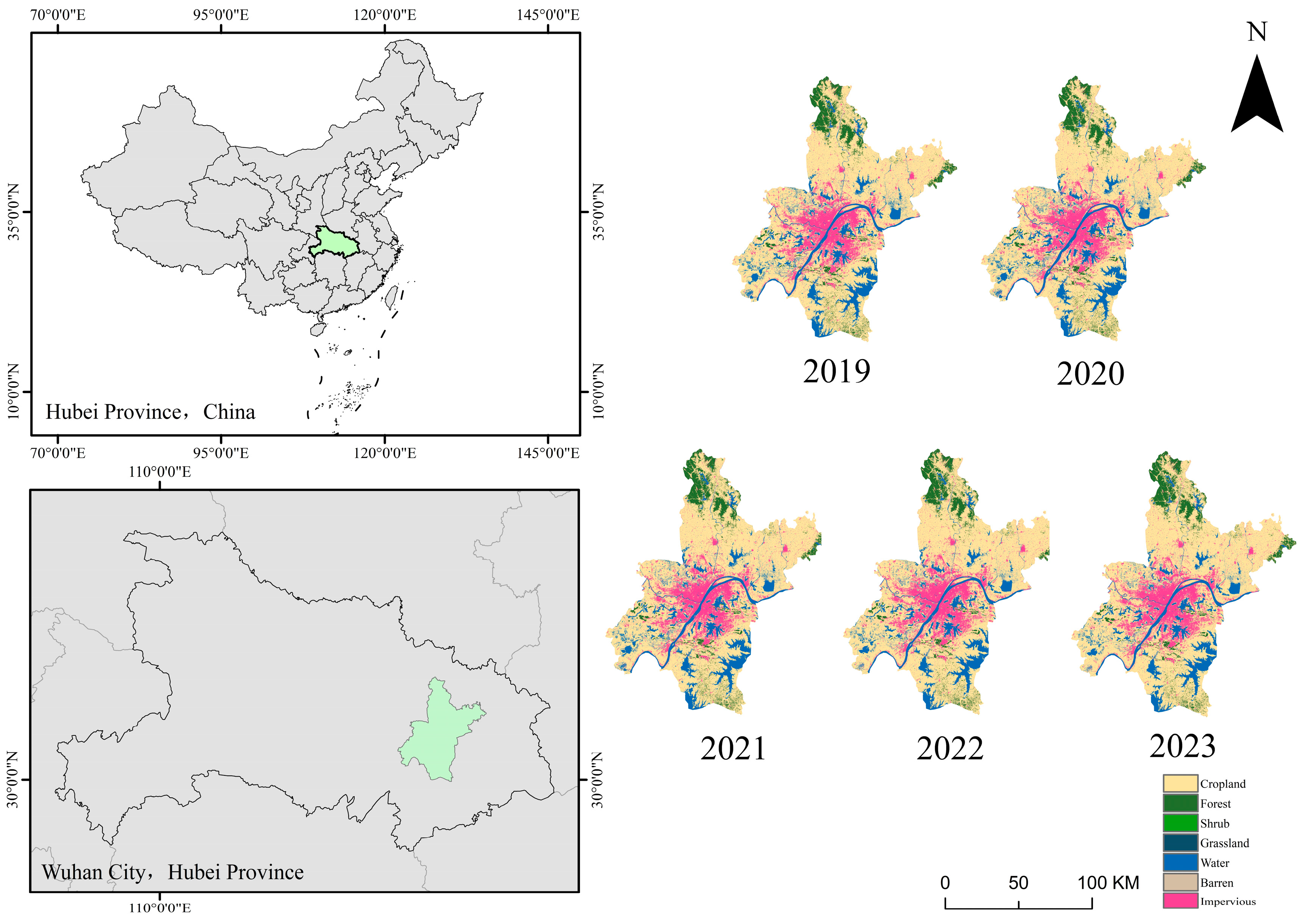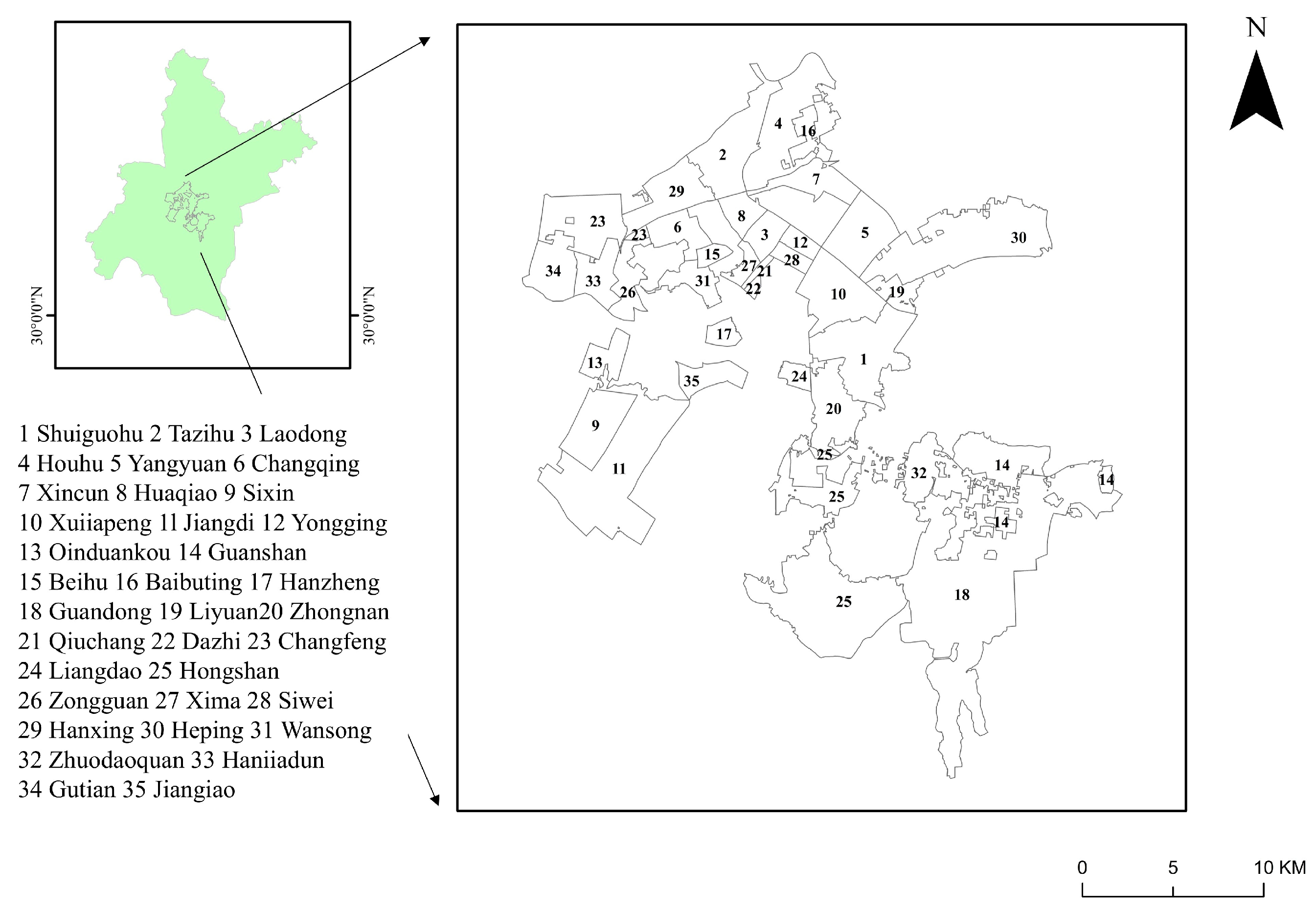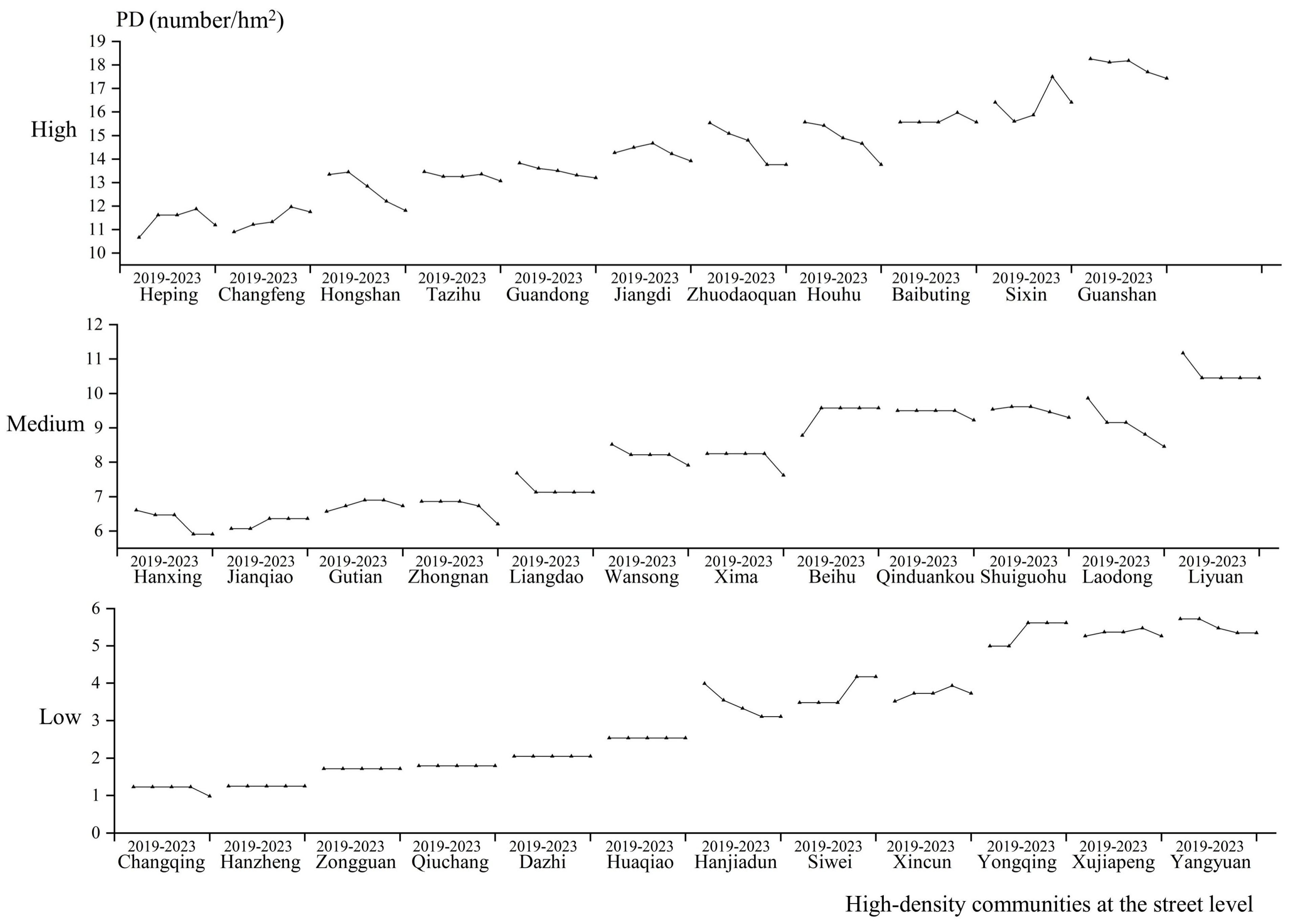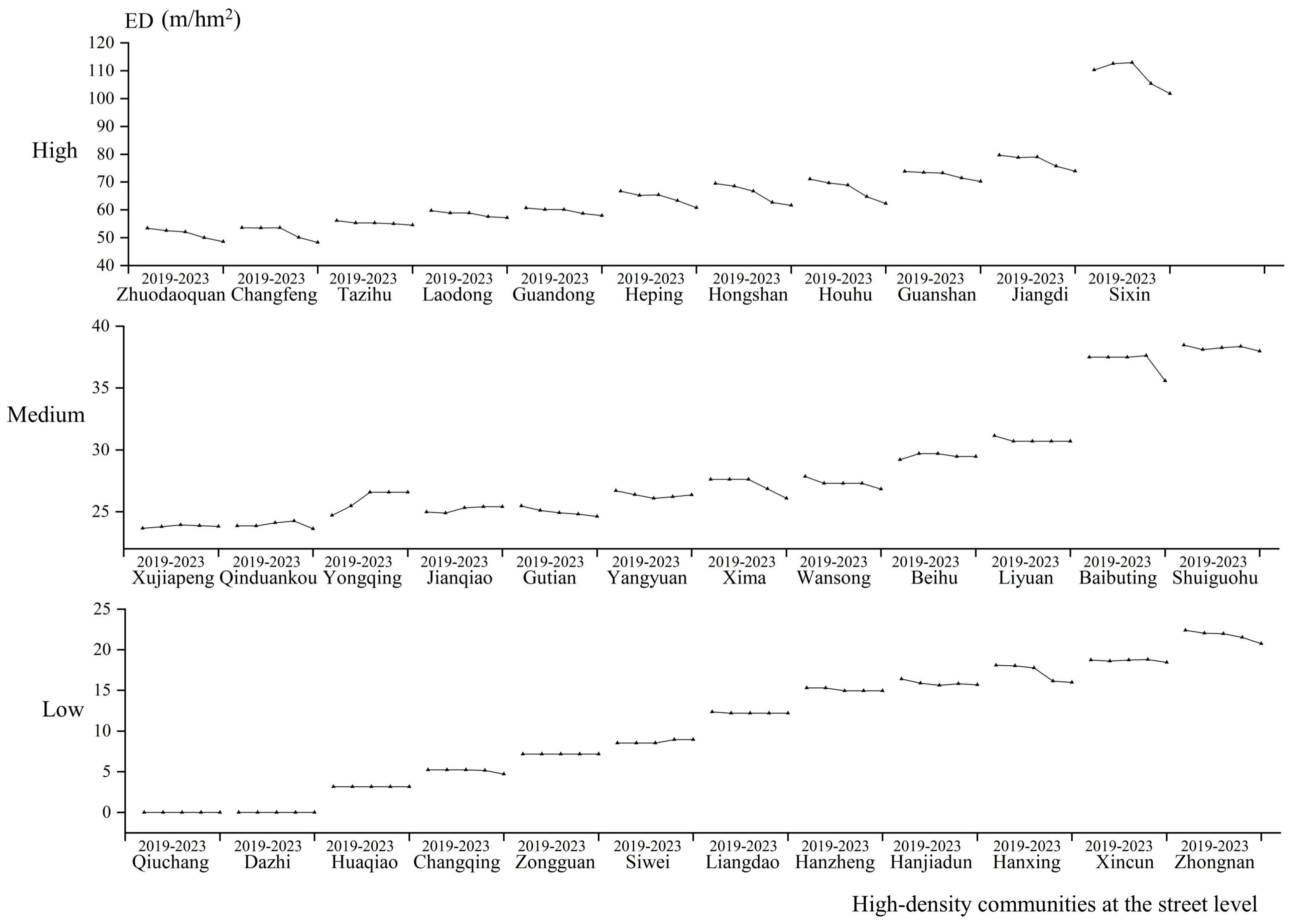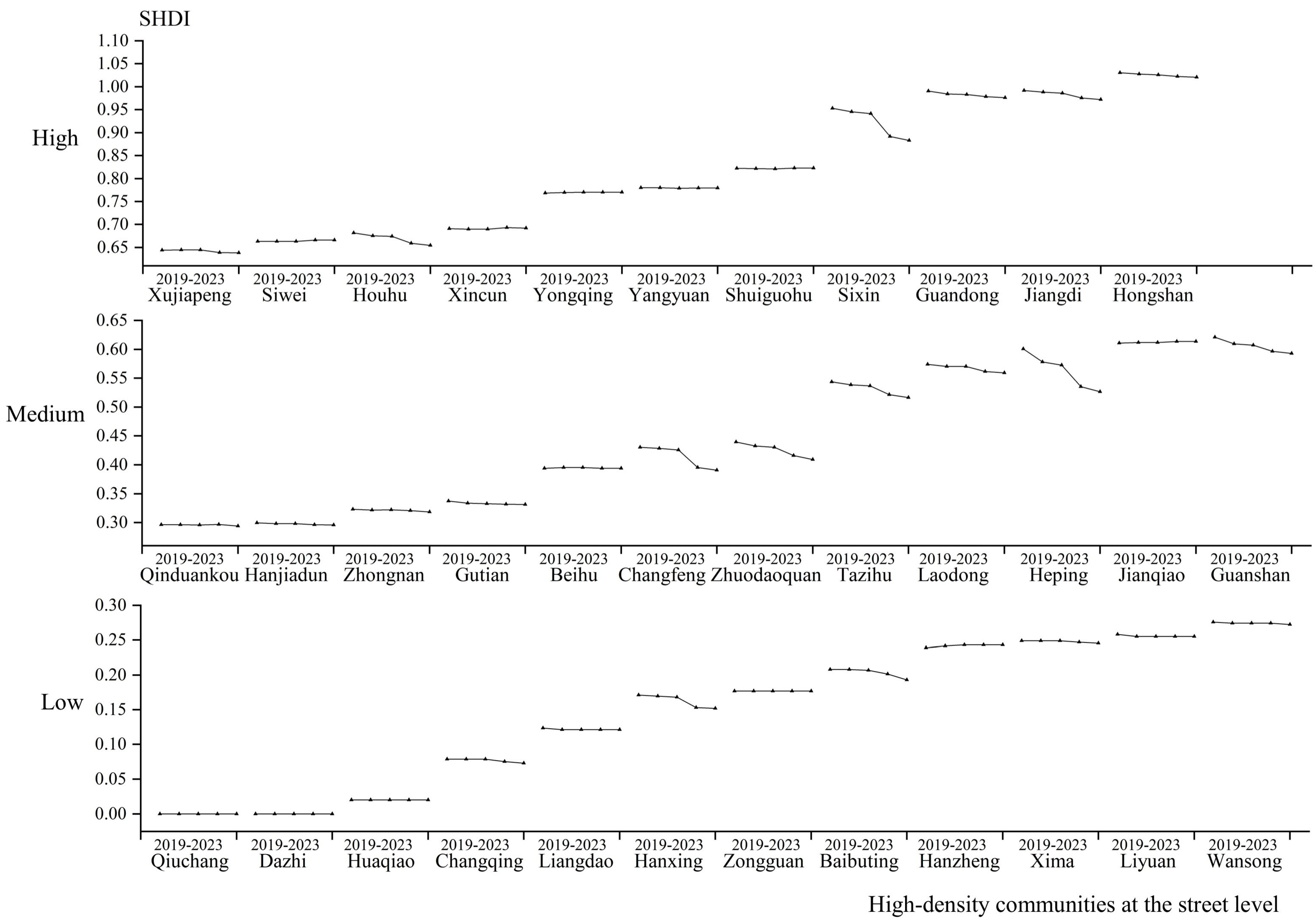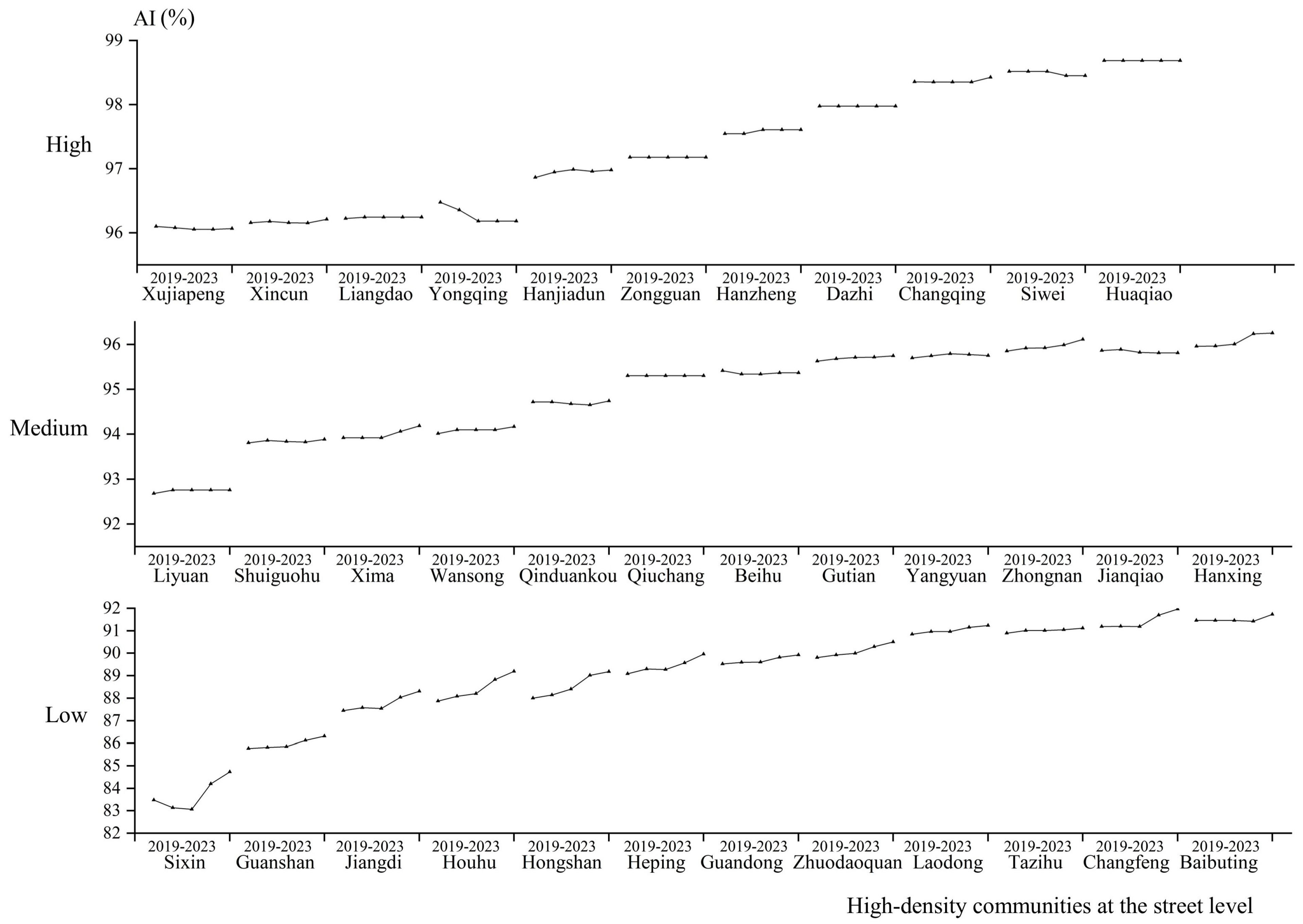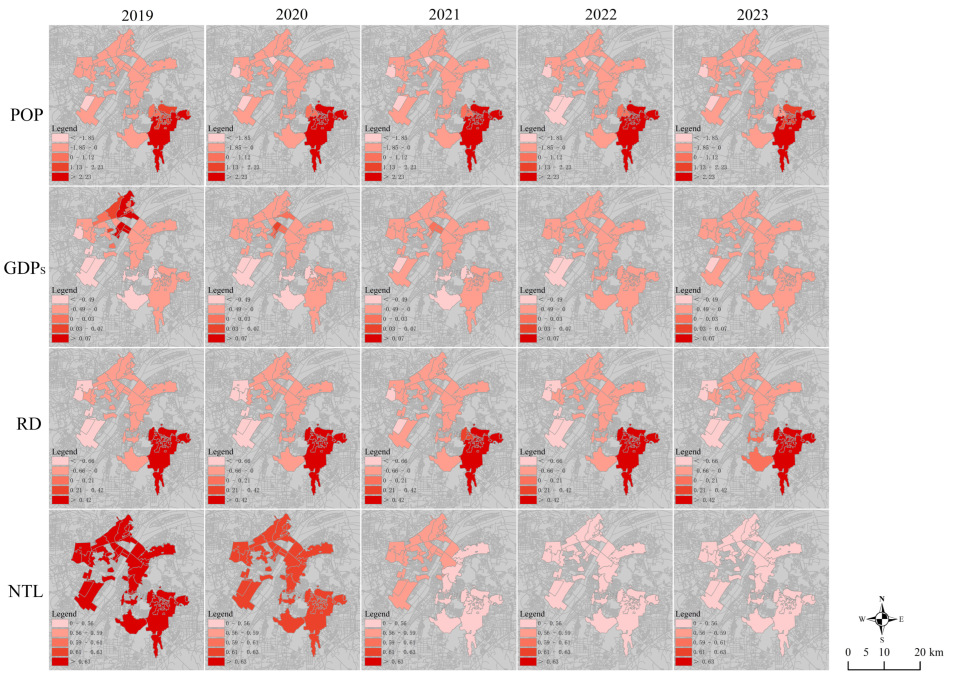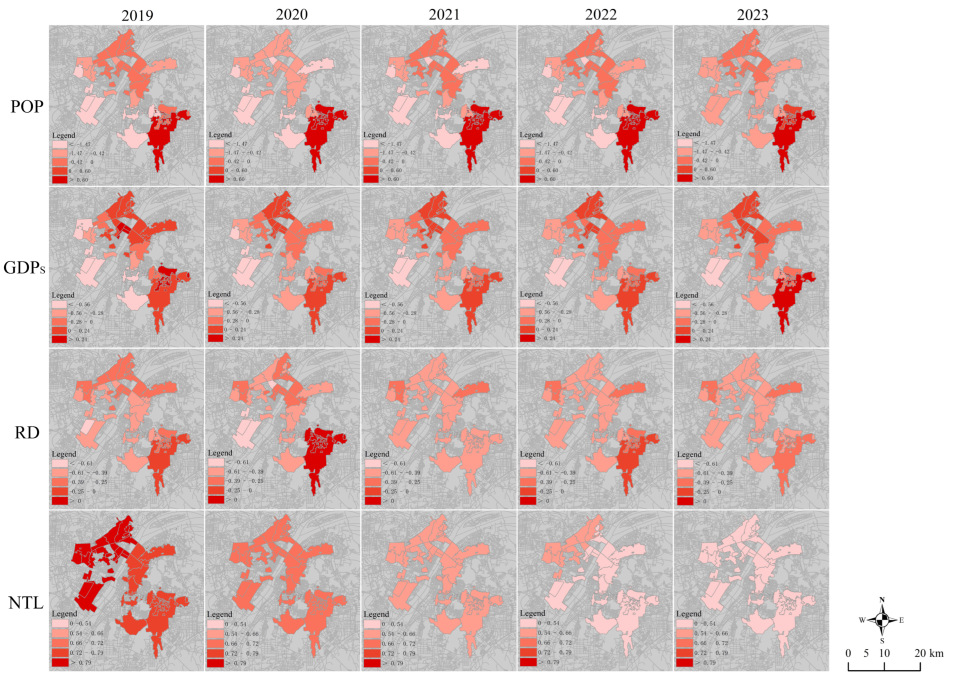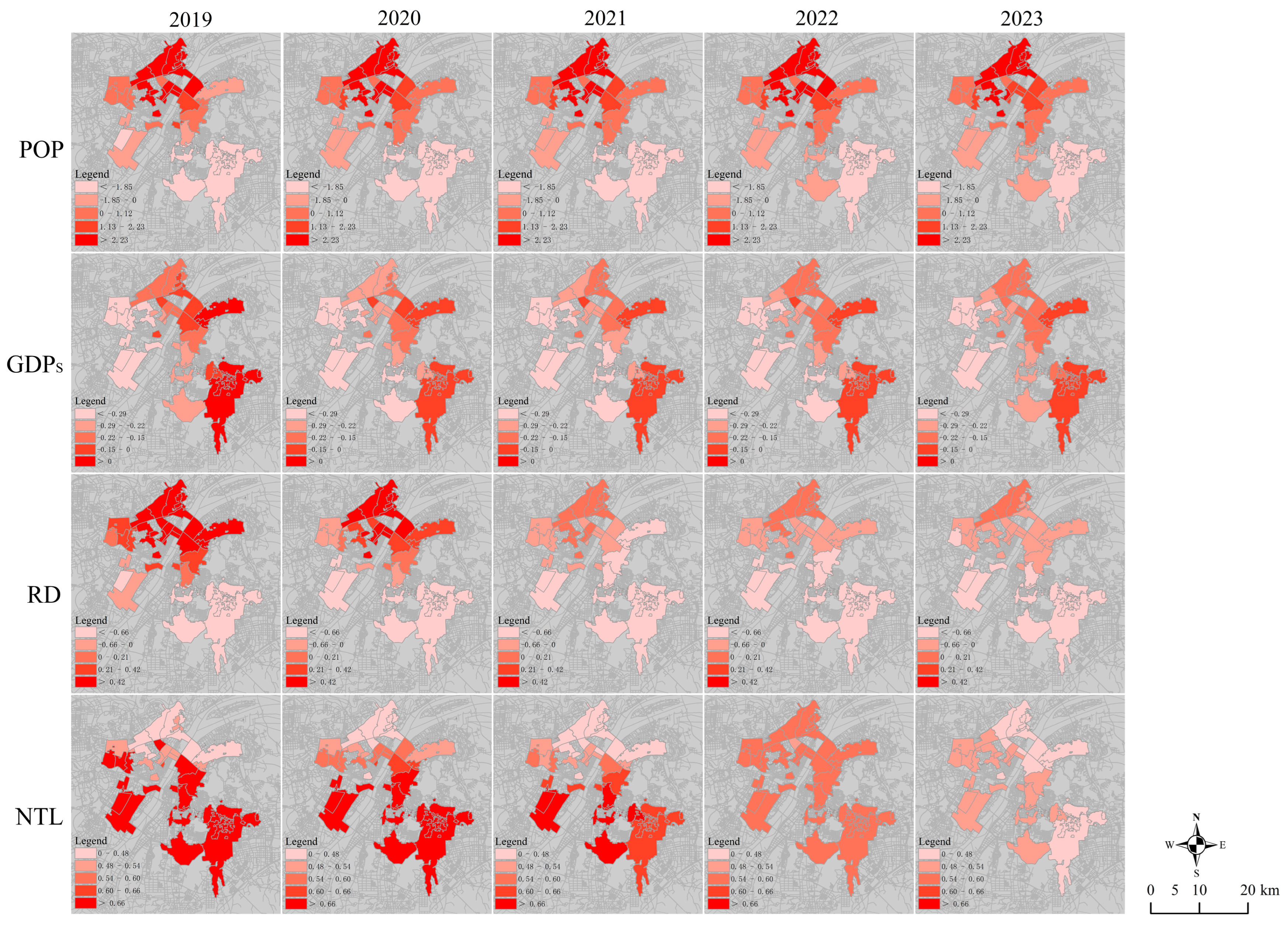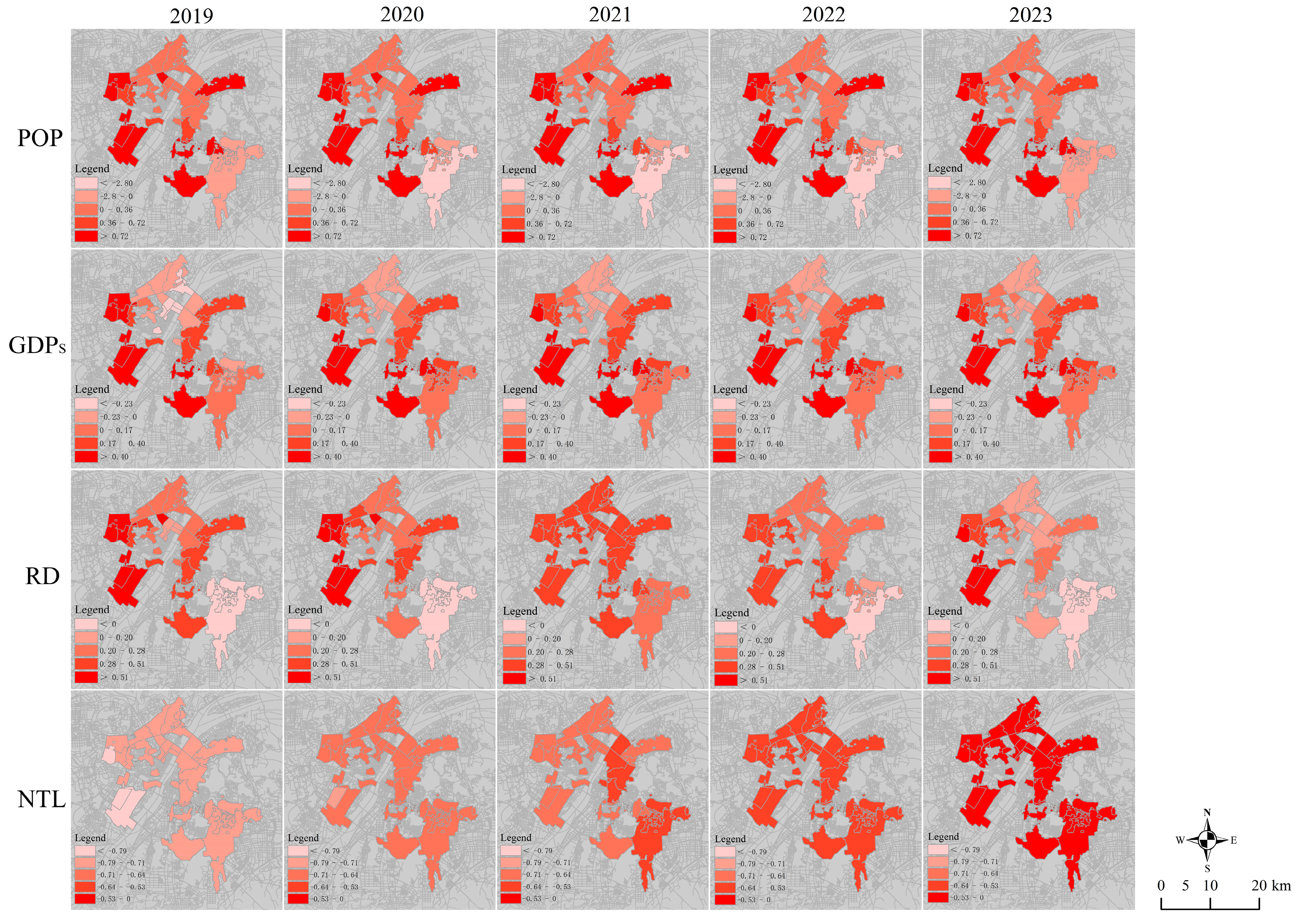3.1. Evolutionary Characteristics of Landscape Patterns in Wuhan’s High-Density Communities
This study calculated landscape pattern metrics for the period of 2019–2023 using Fragstats 4.2 software, with the results presented in
Table 3. According to
Table 3, ED, PD, and SHDI exhibit consistent annual declines averaging 1.53%, 0.97% and 0.59%, respectively, while AI increased steadily at 0.11% per year. The positive correlation between decreasing PD and ED indicates progressive landscape consolidation with simplified patch boundaries, whereas the inverse relationship between rising AI and declining SHDI suggests aggregation processes reduce ecological diversity. A notable acceleration occurred in 2022, with PD decline intensifying from −1.3% to −2.8% and AI growth expanding from 0.15% to 0.27%, temporally coinciding with Wuhan’s 14th Five-Year Plan for Urban Renewal Initiatives. These metrics collectively demonstrate that anthropogenic landscape modification through urban expansion has exceeded natural succession processes in shaping landscape patterns during the study period.
To investigate how urban renewal, infrastructure development and ecological restoration collectively influence landscape patterns, this study analyzed street-level spatiotemporal changes in four landscape indices—PD, ED, SHDI and AI—across high-density communities from 2019 to 2023. Moreover, to more effectively and clearly illustrate landscape dynamics and regional variations, the 35 streets were categorized into three groups (12, 12, and 11 units, respectively) and the landscape metrics were classified into three tiers—low, medium, and high—as shown in
Figure 3,
Figure 4,
Figure 5 and
Figure 6.
Figure 3 classified PD values into three distinct gradient intervals: low (0–6), medium (6–12), and high (12–19), revealing three key trends. First, most high-density communities exhibited declining PD values, particularly the Hongshan, Zhuodaoquan, Houhu, Laodong and Hanjiadun streets, where urban renewal and ecological restoration projects consolidated fragmented plots and enhanced patch connectivity. Second, nine communities, including the Heping and Changfeng streets, showed increasing PD values, primarily due to transportation infrastructure fragmenting green spaces and agricultural embankments disrupting aquatic ecosystems, exacerbating landscape fragmentation. Specifically, the Sixin street displayed an inverted N-shaped PD fluctuation: PD decreased from 2019 to 2020 due to the renovation of old neighborhoods and optimized land use efficiency, then increased between 2020 and 2022 owing to inefficient land development and road fragmentation, and declined again from 2022 to 2023 as a result of land redevelopment and ecological restoration. Third, six communities, including the Hanzheng and Zongguan streets, maintained stable PD values below three throughout the study period. Collectively, these observed patterns demonstrate human activities’ substantial influence on urban landscape evolution.
Figure 4 demonstrates distinct ED patterns across communities from 2019 to 2023. The majority of high-density communities displayed ED values within low (0–40) and medium (25–40) ranges, exhibiting varying characteristic trends: predominantly declining, partially stable, and minimally increasing patterns. For instance, the Hanxing and Baibuting streets showed significant ED declines, resulting from industrial-to-residential conversions that regularized plot geometry and improved spatial integration. In contrast, the Qiuchang and Dazhi streets consistently recorded zero ED values, indicating their uniform ecological structures with homogeneous landscapes. Notably, the Yongqing street displayed that initially, ED increased from urban renewal-induced fragmentation of natural patches into smaller construction parcels, followed by stabilization post-2021 when Wuhan’s construction land restrictions saturated the development capacity of this community and fixed its landscape configuration. Furthermore, among the 11 remaining communities with elevated ED values (40–120), most showed downward trends. Specially, the Sixin street, located in a core construction zone, sustained ED values above 100, initially rising (2019–2021) from intensive infrastructure expansion and inefficient land use before declining post-2021 through systematic plot consolidation and ecological restoration. These ED patterns demonstrate how land use changes, policy interventions, and ecological planning collectively reshape density community landscapes, highlighting both regulatory impacts on fragmentation and regional development variations.
Figure 5 reveals three distinct SHDI ranges across all communities: low (0–0.3), medium (0.3–0.65), and high (0.65–1), with 2019–2023 trends showing either stability or decline. Specifically, over 20 streets maintained stable SHDI values, as exemplified by the Qiuchang and Dazhi streets, where persistent zero values reflect uniform ecological structures. In contrast, the remaining streets exhibited declining SHDI values, signaling progressive landscape diversity loss due to urban functional specialization and concentrated land use patterns. Notably, the Heping, Sixin and Changfeng streets experienced the most pronounced decreases: Heping through road or block reconstruction, Sixin via wetland isolation from natural transition zones, and Changfeng by built-up area homogenization—all of which collectively replaced natural/semi-natural spaces with uniform industrial/commercial developments, thereby reducing ecological diversity. Ultimately, these trends demonstrate how systematic land use intensification and functional zoning fundamentally reconfigure ecological diversity patterns in urbanization.
Figure 6 reveals that from 2019 to 2023, most high-density communities had medium (92–96) to high (96–99) AI values, with only a minority falling in the low range (82–92). While most communities showed minor AI fluctuations due to small-scale interventions like greening upgrades that subtly modified land use patterns, others showed more pronounced trends. Notably, communities with AI values below 90 experienced significant increases as concentrated development enhanced the spatial aggregation of similar land uses. The Sixin street exemplified this upward trajectory after an initial decline, where transport infrastructure development (e.g., road expansion, Metro Line 12 construction) during 2019–2021 temporarily fragmented urban patches before subsequent infrastructure completion and ecological corridor establishment restored spatial aggregation. Conversely, streets like the Yongqing street showed marked AI decreases, resulting from urban renewal projects that introduced scattered, irregularly shaped features such as pocket parks and commercial outlets, thereby reducing spatial cohesion across the landscape.
In summary, the above reveals clear spatiotemporal heterogeneity in street-level landscape patterns across Wuhan’s high-density communities during 2019–2023, driven by integrated urban interventions, including renewal, plot consolidation, infrastructure expansion, ecological restoration, and zoning policies. The varied transformation pathways observed across dense communities emphasize the inherent complexity of ecological responses to urban land use change. To reconcile development with sustainability, future planning should prioritize multifunctional strategies that simultaneously optimize land use efficiency, ecological connectivity, and landscape diversity, ensuring synergistic alignment of urban structure and ecosystem functionality.
3.2. Spatiotemporal Heterogeneity in Landscape Patterns Driven by Socioeconomic Factors
This study utilizes ArcGIS 10.8 and GWR modeling to quantify spatial non-stationarity in socioeconomic drivers (2019–2023), exploring their heterogeneous impacts on four landscape metrics: PD, ED, SHDI, and AI.
Figure 7,
Figure 8,
Figure 9 and
Figure 10 visualized the spatially varying regression coefficients (β), revealing localized effect magnitudes across the urban fabric.
For PD,
Figure 7 reveals distinct socioeconomic influences: (1) POP generally exhibits a negative correlation with PD, averaging
β = −0.48, suggesting that population concentration promotes landscape integration. Notably, the Gutian and Jiangdi streets demonstrate progressively intensifying negative POP-PD correlations (∆
β = −0.21/year and −0.11/year, respectively), indicating their increasing effectiveness in suppressing landscape fragmentation through population concentration. However, exceptions such as the Guandong and Guanshan streets show a positive correlation (average
β = +5.53 and +2.55, respectively), attributed to scattered expansion patterns. (2) GDPs primarily exerts negative effects on PD (average
β = −0.20), with varying intensity across communities. Mature areas like the Yongqing and Qiuchang streets exhibit weak GDPs-induced fragmentation inhibition (
β = −0.02 and −0.02, respectively), whereas economic zones like the Zhuodaoquan street show stronger negative effects (
β = −0.52). Meanwhile, the Xincun (
β = +0.07 in 2019 → −0.04 in 2023) and Laodong streets (
β = +0.10 → −0.02) transitioned from positive to negative, signaling improved landscape integration driven by economic development. (3) RD generally reduces PD (average
β = −0.33) by enhancing landscape connectivity in most communities. Yet, in the Guanshan and Guandong streets, RD correlates positively with PD (
β = +0.56 and +0.56, respectively) due to the disordered road expansion that fragments the landscape. Moreover, stable temporal coefficients reflect the city’s shift from expansive growth to refined urban renewal. (4) NTL intensity consistently increases PD (average
β = 0.56), linking elevated urban activity to landscape fragmentation. However, NTL’s regression coefficients decline annually with ∆
β = −0.06/year, suggesting diminishing fragmentation impacts over time due to stabilized urban structures or green planning interventions.
For ED,
Figure 8 reveals that: (1) POP predominantly exhibits a negative association with ED (average
β = −0.77), demonstrating the land plot regularization and edge simplification effects of concentrated development. However, certain communities display positive POP-ED relationships, wherein population growth drives the expansion of fragmented construction land and increased edge complexity. A notable example is the Guanshan street, where the POP–ED relationship transitioned from negative (2019:
β = −0.00028) to positive (2021:
β = +1.05) and subsequently to a weakened effect (2023:
β = +0.17), reflecting progressive urban renewal implementation. (2) GDPs displays divergent effects on ED across communities: reducing ED in the Sixin (
β = −1.22) and Jiangdi streets (
β = −0.82) through land integration and edge simplification, while increasing ED in the Guandong (
β = +0.20) and Yongqing streets (
β = +0.12) via irregular development patterns. Notably, the Guanshan street undergoes a progressive transition from a positive GDPs–ED correlation in 2019 (
β = +0.29) to a negative correlation by 2023 (
β = −0.05), signaling enhanced landscape integration associated with the maturing economic activities. (3) RD typically exhibits a negative correlation with ED (average
β = −0.43), reflecting that road network development contributes to spatial structure optimization and landscape boundary simplification. Notably, the Guandong street displayed a three-phase evolution: during initial construction (2019), RD reduced ED (
β = −0.10) through systematic plot integration; subsequent scattered expansion (2020) increased edge complexity (
β = +0.26) due to uncoordinated development; and post-2021 urban renewal restored negative correlation (
β = −0.48) through integrated infrastructure planning, showcasing how phased interventions can progressively enhance landscape connectivity. (4) NTL intensity shows a consistently positive correlation with ED across all communities (average
β = +0.64), linking heightened urban activity to greater landscape edge complexity. However, the effect diminished over time (∆
β = −0.07/year), reflecting the progressive stabilization of urban form as development matures, and successful mitigation through green infrastructure investments and compact city planning. This attenuation is particularly evident in communities like the Sixin street, where NTL-ED coefficients declined from
β = +0.79 (2019) to
β = +0.51 (2023), validating the effectiveness of light pollution reduction strategies and spatial planning interventions.
For SHDI,
Figure 9 demonstrates that: (1) POP exhibits a significant negative correlation with SHDI (
β = −1.33,
p < 0.01), reflecting that urban densification reduces landscape heterogeneity through land use intensification and functional homogenization. The Hongshan street exemplifies a promising mitigation trend, where the POP–SHDI effect has attenuated annually (∆
β = +0.07/year), declining form
β = −3.95 in 2019 to
β = −3.67 in 2023. This decoupling reflects the successful implementation of targeted ecological preservation policies, alongside improved land use efficiency achieved through mixed-use zoning. (2) GDPs demonstrates transitional effects on SHDI: the Guanshan (
β = +0.21 → −0.15) and Guandong streets (
β = +0.55 → −0.13) show clear economic encroachment through their positive-to-negative coefficient shifts, while the Beihu (
β = −0.261 ± 0.015) and Changqing streets (
β = −0.307 ± 0.017) maintained stable ecological integration despite development pressures. (3) RD predominantly shows a persistent negative correlation with SHDI (mean
β = −0.50,
p < 0.01), demonstrating that road network expansion drives landscape homogenization through geometric regularization of land parcels, fragmentation of ecological patches, and centralized development patterns. This trend is particularly pronounced in the Hanzheng street, where RD–SHDI coefficients intensify from
β = −0.34 (2019) to
β = −0.48 (2023) (∆
β = −0.03/year), indicating accelerating diversity loss from sustained road infrastructure development. (4) NTL positively correlates with SHDI (
β = +0.55,
p < 0.01), indicating that urban activity enhances diversity through mixed land functions and structural heterogeneity. Concurrently, the annually weakening relationship (∆
β = −0.08/year) reveals an important transition where stabilizing urban structures and implemented green policies gradually reduce these diversity fluctuations as the development matures, as exemplified by the Sixin street’s decline from
β = +0.98 (2019) to
β = +0.49 (2023).
For AI,
Figure 10 demonstrates that: (1) POP exhibits a predominant positive correlation with AI across high-density communities (
β = +0.47,
p < 0.05), reflecting urban renewal and land use restructuring driven by population growth, enhancing patch consolidation. However, the Guanshan street exemplifies a characteristic mitigation pattern, where the POP–AI relationship transitioned from strong negative effects (
β = −0.74 in 2019) to progressively weaker impacts (
β = −1.08 in 2023, ∆
β = +0.09/year), reflecting how progressive environment upgrades and ecological interventions can mitigate population-driven disaggregation. (2) GDPs demonstrates divergent AI relationships. Most communities, including mature communities like the Shuiguohu (
β = + 0.23) and Changqing streets (
β = +0.13), show persistent positive correlations through concentrated functional zoning and stable land use. Conversely, a minority exhibited a weakening negative effect (e.g., the Baibuting street:
β = −0.23 → −0.03; the Yongqing street:
β = −0.37 → −0.08) as infill development mitigates residential fragmentation. Specifically, the Yangyuan street’s transition from negative (
β = −0.06, 2019) to positive GDPs–AI correlations (
β = +0.05, 2023) highlights how rapid economic growth can eventually enhance spatial aggregation when accompanied by strategic planning interventions. (3) RD generally increases AI (
β = +0.28) through improved connectivity. For instance, the Houhu street shows a characteristic rise-and-decline pattern in road network efficacy—initial infrastructure expansion (2019–2021) significantly improved connectivity (peak
β = +0.32 in 2020), followed by diminishing aggregation returns by 2023 (
β = +0.22) as the network approached saturation. (4) NLT negatively correlates with AI across most communities (
β = −0.63,
p < 0.01), as frequent nocturnal activity fragments land plots and mixes functions, reducing patch cohesion. For instance, the Sixin (
β = −0.79 to −0.51) and Jiangdi streets (
β = −0.79 to −0.50) both show weakening negative trends (∆
β = +0.07/year), confirming the effectiveness of implemented light pollution controls and green space renovations in stabilizing landscape patterns.
In summary, the above reveals pronounced spatiotemporal heterogeneity in how socioeconomic factors shape urban landscape patterns. POP and RD directly reduce fragmentation through physical development integration, while GDPs and NLT indirectly influence patterns via economic restructuring and land use changes. NTL particularly enhances fragmentation and edge complexity. These drivers collectively generate distinct spatial patterns across high-density communities, as demonstrated by our geographically varying regression analyses.
